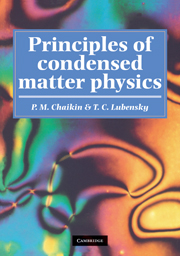Book contents
- Frontmatter
- Contents
- Preface
- 1 Overview
- 2 Structure and scattering
- 3 Thermodynamics and statistical mechanics
- 4 Mean-field theory
- 5 Field theories, critical phenomena, and the renormalization group
- 6 Generalized elasticity
- 7 Dynamics: correlation and response
- 8 Hydrodynamics
- 9 Topological defects
- 10 Walls, kinks and solitons
- Glossary
- Index
Preface
Published online by Cambridge University Press: 05 June 2012
- Frontmatter
- Contents
- Preface
- 1 Overview
- 2 Structure and scattering
- 3 Thermodynamics and statistical mechanics
- 4 Mean-field theory
- 5 Field theories, critical phenomena, and the renormalization group
- 6 Generalized elasticity
- 7 Dynamics: correlation and response
- 8 Hydrodynamics
- 9 Topological defects
- 10 Walls, kinks and solitons
- Glossary
- Index
Summary
The use and understanding of matter in its condensed (liquid or solid) state have gone hand in hand with the advances of civilization and technology since the first use of primitive tools. So important has the control of condensed matter been to man that historical ages – the Stone Age, the Bronze Age, the Iron Age – have often been named after the material dominating the technology of the time. Serious scientific study of condensed matter began shortly after the Newtonian revolution. By the end of the nineteenth century, the foundations of our understanding of the macroscopic properties of matter were firmly in place. Thermodynamics, hydrodynamics and elasticity together provided an essentially complete description of the static and dynamic properties of gases, liquids and solids at length scales long compared to molecular lengths. These theories remain valid today. By the early and mid-twentieth century, new ideas, most notably quantum mechanics and new experimental probes, such as scattering and optical spectroscopy, had been introduced. These established the atomic nature of matter and opened the door for investigations and understanding of condensed matter at the microscopic level. The study of quantum properties of solids began in the 1920s and continues today in what we might term “conventional solid state physics”. This field includes accomplishments ranging from electronic band theory, which explains metals, insulators and semiconductors, to the theory of superconductivity and the quantum Hall effect.
- Type
- Chapter
- Information
- Principles of Condensed Matter Physics , pp. xvii - xxPublisher: Cambridge University PressPrint publication year: 1995

